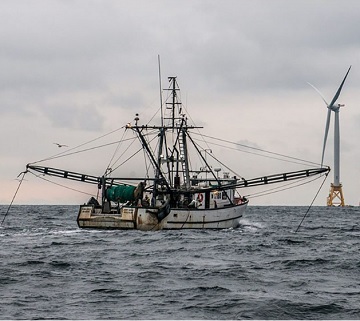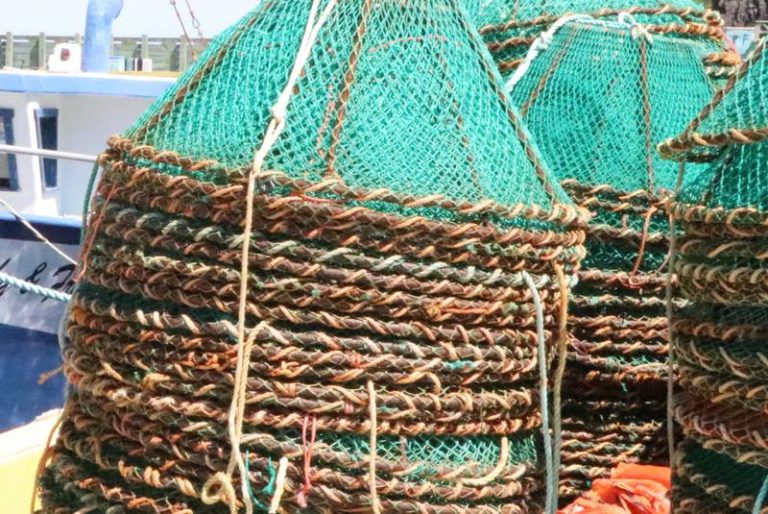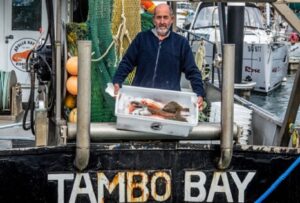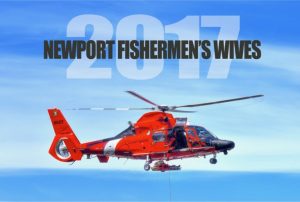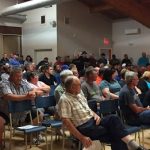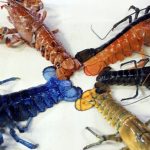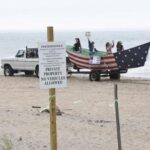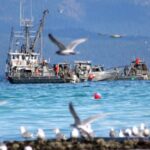Tag Archives: new-york
BOEM Aims to Control Offshore Wind Developments’ Risk to Right Whales
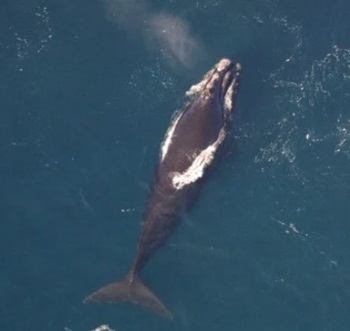 In advance of future offshore wind development in the New York Bight, the Bureau of Ocean Energy Management is preparing a region-wide environmental impact statement, paving the way for faster federal permitting of each individual project down the road. If built out, the future projects would mean the installation of about 1,100 turbines, 22 offshore substations and 1,600 miles of subsea cable. Without mitigation, BOEM expects the development of six offshore wind farms would have a “major” impact on right whales because of the noise from pile driving, blasting of unexploded ordnance, entanglement in abandoned gear and vessel strikes. North Atlantic right whales are so endangered that each individual death has a substantial impact, and additional losses cannot be absorbed – so BOEM wants to control the risk. more, >>click to read<< 09:15
In advance of future offshore wind development in the New York Bight, the Bureau of Ocean Energy Management is preparing a region-wide environmental impact statement, paving the way for faster federal permitting of each individual project down the road. If built out, the future projects would mean the installation of about 1,100 turbines, 22 offshore substations and 1,600 miles of subsea cable. Without mitigation, BOEM expects the development of six offshore wind farms would have a “major” impact on right whales because of the noise from pile driving, blasting of unexploded ordnance, entanglement in abandoned gear and vessel strikes. North Atlantic right whales are so endangered that each individual death has a substantial impact, and additional losses cannot be absorbed – so BOEM wants to control the risk. more, >>click to read<< 09:15

Whales and other marine life are still dying. The crisis at the NJ Shore remains urgent
It’s worth noting that it has been a full year since coastal residents realized that there was something amiss in our oceans — the start of a frightening number of whale and dolphin deaths. In the New Jersey and New York area alone, there have been 38 whales and 60 dolphins and porpoises washed ashore. That’s 98 endangered marine mammals found dead. That’s almost two marine mammals per week, while others have sunk to the bottom of the ocean. Meanwhile, the federal agencies responsible to protect marine mammals have neglected their responsibility, and turned down opportunities to cooperate, be transparent and engage in meaningful dialogue. Video, more, >>click to read<< 11:48
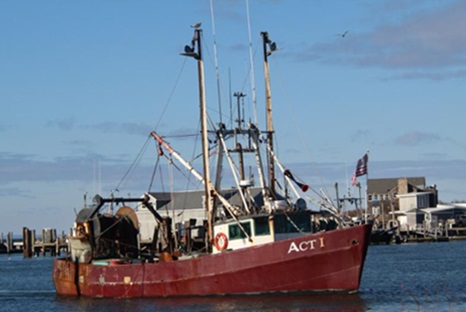
A Sinking Trawler Is Saved
When Capt. Chuck Morici’s boat was sinking 15 miles from Montauk Point on Nov. 15, he did what people do in 2023: He made a short video. Orange haze from a smoke flare he had thrown in the water swirled around the boat. He pointed the camera below deck to show water, rising rapidly. “There she goes. I just want to cry. We’re going down.” Minutes later, after the Coast Guard had arrived, he made a second video. “You might not like the Coast Guard when they measure your fish, but you sure like them when they show up and save your ass,” he said before panning to a Coast Guardsman descending below deck. “I was fishing next to Capt. Dave Aripotch in heavy currents. I told him I was having trouble and asked him to come pick up my crew. I put them in survival suits immediately. Dave backed up, stern to stern, and he took care of my guys.” >>click to read<< 15:21
Fishing industry’s fight against offshore wind farms reaches far and wide
 Off the coast of Montauk, New York is some of the most fertile fishing grounds in all of North America. It is an area that has been sustainably fished for over 400 years, feeding countless Americans along the way. It also happens to be an area where energy companies, some foreign-owned, are trying to install offshore wind farms. Political agendas and lobbyist pull strings have put that sustainable fishing at risk. As a result, the Vineyard Wind project has embroiled generational fishermen into a lawsuit, and a battle for their own profession. Roy Maynard of the Texas Public Policy Foundation says there has not even been proper checks and balances. >>click to read<< 07:26
Off the coast of Montauk, New York is some of the most fertile fishing grounds in all of North America. It is an area that has been sustainably fished for over 400 years, feeding countless Americans along the way. It also happens to be an area where energy companies, some foreign-owned, are trying to install offshore wind farms. Political agendas and lobbyist pull strings have put that sustainable fishing at risk. As a result, the Vineyard Wind project has embroiled generational fishermen into a lawsuit, and a battle for their own profession. Roy Maynard of the Texas Public Policy Foundation says there has not even been proper checks and balances. >>click to read<< 07:26
Opening of season proves bay scallops are hard to find
 While the rest of us admire fall foliage, North Fork baymen look to nature for signs that predict the health of adult bay scallops. They watch the docks and parking lots to see if they are littered with broken scallop shells dropped and picked over by gulls; a good sign. They scan the beaches after a strong wind to see if scallops have washed up, another good sign. This year, once again, the signs were not encouraging. The bay scallop season, which started Monday in New York and runs through March, looks to be just as bad this year as it has been for the past four, which means the most reliable way to get a bay scallop dinner is to know a fisherman — and the most reliable way for a fisherman to make a living is to fish for something else. >>click to read<< 13:03
While the rest of us admire fall foliage, North Fork baymen look to nature for signs that predict the health of adult bay scallops. They watch the docks and parking lots to see if they are littered with broken scallop shells dropped and picked over by gulls; a good sign. They scan the beaches after a strong wind to see if scallops have washed up, another good sign. This year, once again, the signs were not encouraging. The bay scallop season, which started Monday in New York and runs through March, looks to be just as bad this year as it has been for the past four, which means the most reliable way to get a bay scallop dinner is to know a fisherman — and the most reliable way for a fisherman to make a living is to fish for something else. >>click to read<< 13:03
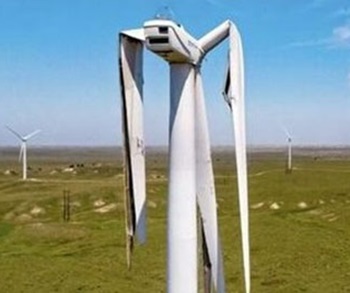
Federal bailout coming for failing offshore wind companies?
Team Biden is preparing a bailout package for the offshore wind industry that it already heavily subsidizes, a report said. The Biden Administration’s plan is to have offshore wind provide enough power to meet the annual demand of 10 million American homes by 2030, according to the White House. Writing in his “Energy Absurdity” Substack, David Blackmon, an energy analyst with over 40 years of experience in the oil and gas industry, said that lobbying is likely to soon begin for Team Biden to dip into taxpayer coffers to pony up more billions in funding for failing wind farms. “Everyone should prepare themselves to see an effort in Washington, D.C. to allocate billions more dollars to bail out Big Offshore Wind developers soon,” Blackmon wrote. >>click to read<< 10:55
Three Fishermen Rescued as Commercial Vessel Sinks Off Hampton Bays
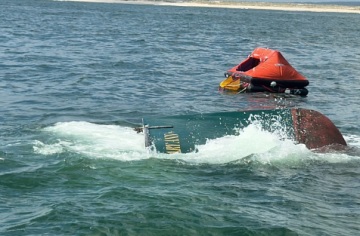 Three commercial fishermen were rescued from the waters off Hampton Bays on Thursday afternoon after the 41-foot trawler they were aboard began rapidly taking on water and sank. According to the U.S. Coast Guard, the fishing vessel Kary Ann sent out a mayday call about noon on Thursday from about one mile south of Shinnecock Inlet. By the time a Coast Guard launch reached the scene, the three fishermen who were aboard had abandoned ship. >>click to read<<< 13:30
Three commercial fishermen were rescued from the waters off Hampton Bays on Thursday afternoon after the 41-foot trawler they were aboard began rapidly taking on water and sank. According to the U.S. Coast Guard, the fishing vessel Kary Ann sent out a mayday call about noon on Thursday from about one mile south of Shinnecock Inlet. By the time a Coast Guard launch reached the scene, the three fishermen who were aboard had abandoned ship. >>click to read<<< 13:30
Small town fisherman harpooned on federal charges for catch that’s legal in other states: lawyer
 The 63-year-old captain of a Montauk, New York, fishing trawler has been convicted of federal conspiracy and fraud charges for violating local fishing rules that his lawyers say are outdated, wasteful and wouldn’t be a crime in other states. A federal jury found Christopher Winkler, who owns the 45-foot trawler named New Age that is based on Long Island’s East End, guilty of five counts last week – two each of mail fraud and obstruction of justice and one more for criminal conspiracy for an overfishing plot that racked up nearly $1 million in proceeds. The problem is, according to his defense, if Winkler had caught the fish in neighboring New Jersey, there likely wouldn’t have been a crime at all. Photos, >>click to read<< 07:53
The 63-year-old captain of a Montauk, New York, fishing trawler has been convicted of federal conspiracy and fraud charges for violating local fishing rules that his lawyers say are outdated, wasteful and wouldn’t be a crime in other states. A federal jury found Christopher Winkler, who owns the 45-foot trawler named New Age that is based on Long Island’s East End, guilty of five counts last week – two each of mail fraud and obstruction of justice and one more for criminal conspiracy for an overfishing plot that racked up nearly $1 million in proceeds. The problem is, according to his defense, if Winkler had caught the fish in neighboring New Jersey, there likely wouldn’t have been a crime at all. Photos, >>click to read<< 07:53
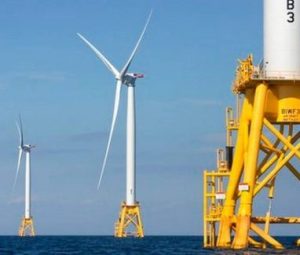
New York Rejects Offshore Wind’s Request to Raise Rates
Offshore wind developers are reevaluating some New York projects after regulators rejected higher rates by Equinor ASA, Orsted A/S and others that would have added as much as $12 billion in costs. Developers planning to build more than 4 gigawatts of wind-power capacity off Long Island must abide by existing contracts to deliver power, the New York Public Service Commission unanimously ruled during a meeting Thursday. The ruling is the latest blow to the US offshore wind industry already contending with inflation and supply-chain issues. The future of projects such as Orsted’s Sunrise Wind is now in question after Thursday’s decision. >>click to read<< 17:06
Federal Jury Convicts Montauk Fisherman
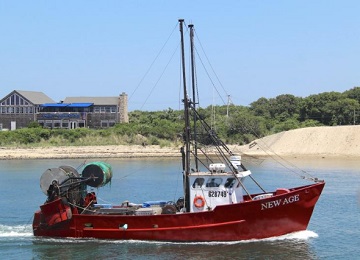 A federal jury convicted a Montauk fisherman on Wednesday of falsifying records in order to sell fluke and black sea bass in quantities that vastly exceeded legal limits. Christopher Winkler, captain of the trawler New Age, was found guilty in federal court in Central Islip on five counts of conspiracy, mail fraud, and obstruction of justice for filing false reports to federal regulators. Bryan and Asa Gosman, both of Montauk, were also initially charged, but the cousins, who are among the owners of Gosman’s Dock in Montauk, cooperated with the prosecution and testified against Mr. Winkler. Each pleaded guilty to one count of conspiracy and were fined. Richard Levitt, an attorney representing Mr. Winkler, said in an email on Wednesday that Mr. Winkler will appeal the conviction. A sentencing date has not been set, he said, nor have sentencing guidelines been determined. >>click to read<< 07:56
A federal jury convicted a Montauk fisherman on Wednesday of falsifying records in order to sell fluke and black sea bass in quantities that vastly exceeded legal limits. Christopher Winkler, captain of the trawler New Age, was found guilty in federal court in Central Islip on five counts of conspiracy, mail fraud, and obstruction of justice for filing false reports to federal regulators. Bryan and Asa Gosman, both of Montauk, were also initially charged, but the cousins, who are among the owners of Gosman’s Dock in Montauk, cooperated with the prosecution and testified against Mr. Winkler. Each pleaded guilty to one count of conspiracy and were fined. Richard Levitt, an attorney representing Mr. Winkler, said in an email on Wednesday that Mr. Winkler will appeal the conviction. A sentencing date has not been set, he said, nor have sentencing guidelines been determined. >>click to read<< 07:56
Fisherman Convicted in Plot to Sell $900,000 of Illegal Fluke and Bass
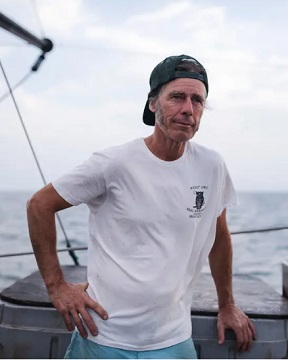 A Montauk, N.Y., fisherman accused of vastly exceeding legal limits on how much fluke he could bring ashore was convicted on all charges in a federal court in Central Islip on Wednesday. Chris Winkler, 63, captain of a 45-foot trawler called the F/V New Age, was accused of falsifying records in order to sell illegal fluke, also known as summer flounder, and black sea bass to partners from Gosman’s Dock, a mini-empire of restaurants and shops in Montauk, and dealers in the New Fulton Fish Market in the Bronx. Prosecutors said the over-quota fish was worth nearly $900,000 on the wholesale market. Two cousins from the Gosman family were initially charged — but they flipped and testified against Mr. Winkler, with one claiming he had helped the F/V New Age evade detection by the Coast Guard. Mr. Winkler could face many years in prison on five charges of conspiracy, obstruction and mail fraud, though he is unlikely to receive a lengthy sentence under federal sentencing practices. He was stoic as the verdict was read in court on Wednesday. His lawyer Richard W. Levitt vowed to appeal, and said the case was based on outdated legal limits on fluke fishing. “There is nothing at all rational about this system, but Mr. Winkler and other Long Island fishermen are easy scapegoats for this regulatory insanity,” he said. >>click to read<< 15:28
A Montauk, N.Y., fisherman accused of vastly exceeding legal limits on how much fluke he could bring ashore was convicted on all charges in a federal court in Central Islip on Wednesday. Chris Winkler, 63, captain of a 45-foot trawler called the F/V New Age, was accused of falsifying records in order to sell illegal fluke, also known as summer flounder, and black sea bass to partners from Gosman’s Dock, a mini-empire of restaurants and shops in Montauk, and dealers in the New Fulton Fish Market in the Bronx. Prosecutors said the over-quota fish was worth nearly $900,000 on the wholesale market. Two cousins from the Gosman family were initially charged — but they flipped and testified against Mr. Winkler, with one claiming he had helped the F/V New Age evade detection by the Coast Guard. Mr. Winkler could face many years in prison on five charges of conspiracy, obstruction and mail fraud, though he is unlikely to receive a lengthy sentence under federal sentencing practices. He was stoic as the verdict was read in court on Wednesday. His lawyer Richard W. Levitt vowed to appeal, and said the case was based on outdated legal limits on fluke fishing. “There is nothing at all rational about this system, but Mr. Winkler and other Long Island fishermen are easy scapegoats for this regulatory insanity,” he said. >>click to read<< 15:28
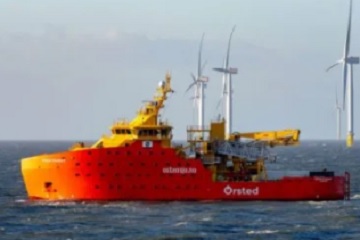
U.S. offshore wind plans are utterly collapsing
Offshore wind developer Ørsted has delayed its New Jersey Ocean Wind 1 project to 2026. Previously, the company had announced construction of the project would begin in October 2023. The delay was attributed to supply chain issues, higher interest rates, and a failure so far to garner enough tax credits from the federal government. For now, they are not walking away from all their U.S. projects but will reconsider long-term plans by the end of this year. Ørsted’s stock price has fallen 30% in 5 days. This is just the latest bad news for offshore win. >>click to read<<10:57
Montauk Fisherman on Trial for Conspiracy, Fraud Related to Fish Selling Scheme
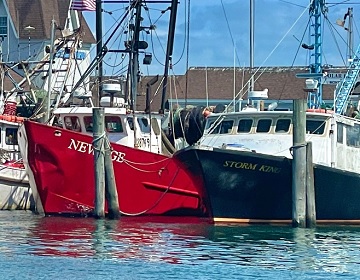 A Montauk commercial fisherman is standing trial in federal court in Islip on felony charges of fraud and conspiracy related to the sale of what the government says was $850,000 worth of illegally caught fish sold through the well-known wholesale fish market Bob Gosman Co. Federal prosecutors have charged Christoper Winkler, 63, with committing wire fraud and mail fraud by falsifying landing reports to under-report exactly how many fish he had caught and sold on hundreds of fishing trips between 2014 and 2017, and by conspiring with the Gosman’s wholesale company to conceal the source of the fish being sold at New York City wholesale markets. Winkler’s vessel, the NEW AGE, is a relatively small, fire engine red, 45-foot steel-hulled commercial trawler that has fished out of Montauk for more than 30 years. >>click to read<< 17:46
A Montauk commercial fisherman is standing trial in federal court in Islip on felony charges of fraud and conspiracy related to the sale of what the government says was $850,000 worth of illegally caught fish sold through the well-known wholesale fish market Bob Gosman Co. Federal prosecutors have charged Christoper Winkler, 63, with committing wire fraud and mail fraud by falsifying landing reports to under-report exactly how many fish he had caught and sold on hundreds of fishing trips between 2014 and 2017, and by conspiring with the Gosman’s wholesale company to conceal the source of the fish being sold at New York City wholesale markets. Winkler’s vessel, the NEW AGE, is a relatively small, fire engine red, 45-foot steel-hulled commercial trawler that has fished out of Montauk for more than 30 years. >>click to read<< 17:46

Proposals could increase wind energy costs 27% to 66%, NYSERDA report says
A report by the state agency leading New York’s transition into a carbon-free energy grid says requests by wind farm developers to sharply increase what they can charge for the power could potentially be 27% to 66% higher than originally proposed. Wind farm companies requesting the increases previously filed documents with the state that excluded from public release most of the now-released financial information. “The economic impact is far too great,” Michelle Leo, a member of Protect Our Coast Long Island, an opposition group in Long Beach, said in an email in response to the release. “Off-shore wind is clearly too expensive because of the return to the investors …” Equinor is lying to the ratepayers that have crappy political representation. >>click to read<< 12:59
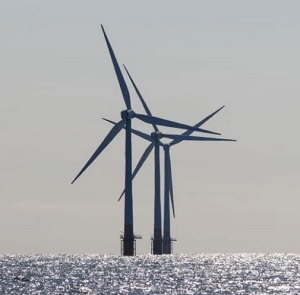
BP & Equinor Demand 54% Hike In Offshore Wind Power Price Increases
BP PlcBP and partner Equinor ASA EQNR are demanding a 54% hike in electricity prices produced at three offshore wind farms in the United States, per a Reuters report. The companies obtained the rights to develop the Empire Wind 1, Empire Wind 2 and Beacon Wind farms offshore New York. Several projects were awarded, and spikes in inflation forced energy companies to hedge equipment and labor at much higher prices than expected. The strike price for Empire Wind 1 would rise from $118.38 per megawatt hour (MWh) to $159.64 per MWh and for Empire Wind 2 from $107.50 per MWh to $177.84 per MWh. Beacon Wind would witness the strike price increase from 118.00 per MWh to 190.82 per MWh. >>click to read<< 11:29
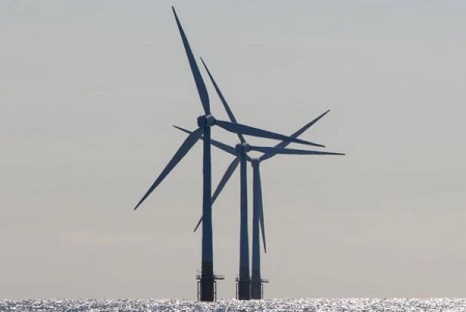
Offshore wind projects may be cancelled in NJ, according to report
Already facing a series of lawsuits and opposition from state and local officials, Danish wind power developer Orsted is reporting huge financial losses. Those losses, company officials warned, could reach $2.3 billion in the U.S and may force the cancellation of projects of the New Jersey coast. In a conference call with investors, Orsted CEO Mads Nipper told them, “If the walk-away scenario is the economical, rational decision for us, then this remains a real scenario for us.” Orsted is considering “walking away” from or cancelling projects in New Jersey, New York, Rhode Island, Connecticut and Maryland. >>click to read<< 08:48
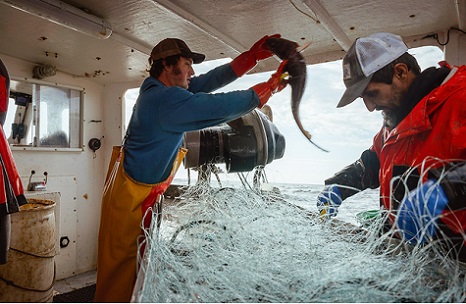
Experts fear American fishing industry, boating at risk as Biden prioritizes climate, green energy
The Biden administration has prioritized green energy at the expense of endangered whales and the U.S. fishing industry with regulation that limits both commercial fishing and recreational boating, according to experts. As they are imposing more regulations, they are also promoting offshore wind, which is actually harming commercial and recreational boating and potentially killing whales, Brady and Lapp said. “They positioned us as being these evildoers and now, 20 years later, whales are dropping dead like pigeons in Manhattan,” Brady said. “Here commercial fishermen and coastal communities are at the front line of fighting to protect the ocean itself, and we have crickets from virtually every NGO.” Video, >>click to read<< 09:09

The NSW commercial fishing industry condemns offshore wind farm proposal for the Hunter and Illawarra regions
Tricia Beatty, Chief Executive Officer of the Professional Fishermen’s Association of NSW said today, “The proposal being considered by the Federal Government is ludicrous and will have a devastating impact on endangered, protected species as well as devastating our commercial fishing families and seafood consumers of New South Wales.” “The studies done to date demonstrates enough evidence that listed threatened species and ecological communities, as well as listed migratory species (protected under international agreements) will be impacted by the proposed wind farms. There is also some opinion amongst the scientific community that there is a link between both the increased mortality rate of whales alongside the expansion of offshore wind infrastructure on the busy coastal cities of New York and New Jersey, although this is still being studied. The areas proposed for the offshore windfarms is in the migratory path of important species such as southern right whales (one of the most endanger large whale species in the world) and humpback whales”, said Ms Beatty. >click to read< 08:40
Save Right Whale Coalition Sickened Over Government Response to Deaths of Whales in NY, NJ
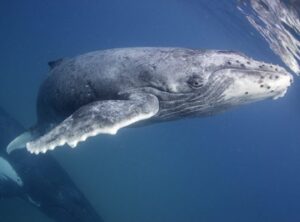 New York and New Jersey are witnessing an alarming increase in whale deaths, with 23 known fatalities in less than a year, sparking concerns and anger among environmental activists and political figures. Critics of offshore wind farm developments, including David Shanker, the New Jersey Spokesperson for Save Right Whales Coalition, are attributing the tragic deaths to sonar blasting activities related to wind turbine construction. A coalition of political figures including Representative Jeff Van Drew (NJ), Representative Jeff Smith (NJ), the Commissioners of Cape May County, and 50 Coastal Mayors have asked President Biden and New Jersey Governor Phil Murphy for a moratorium on the sonar blasting to investigate the cause of the whale deaths. However, their pleas have so far been met with silence, even as the Save Right Whale Coalition prepares to release a documentary with evidence linking sonar testing vessels to whale deaths. >click to read< 07:46
New York and New Jersey are witnessing an alarming increase in whale deaths, with 23 known fatalities in less than a year, sparking concerns and anger among environmental activists and political figures. Critics of offshore wind farm developments, including David Shanker, the New Jersey Spokesperson for Save Right Whales Coalition, are attributing the tragic deaths to sonar blasting activities related to wind turbine construction. A coalition of political figures including Representative Jeff Van Drew (NJ), Representative Jeff Smith (NJ), the Commissioners of Cape May County, and 50 Coastal Mayors have asked President Biden and New Jersey Governor Phil Murphy for a moratorium on the sonar blasting to investigate the cause of the whale deaths. However, their pleas have so far been met with silence, even as the Save Right Whale Coalition prepares to release a documentary with evidence linking sonar testing vessels to whale deaths. >click to read< 07:46
30-foot humpback whale found dead on Fire Island
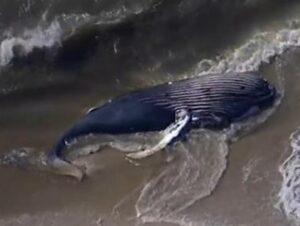 A 30-foot humpback whale was found dead on the shores of Fire Island on Friday morning — at least the 18th doomed humpback discovered on the East Coast so far this year. The tragic majestic mammal was found belly-up on the eastern side of Smith Point County Park in Shirley, Long Island, the National Oceanic and Atmospheric Administration said. The animal’s body has been collected for a necropsy, NOAA told Patch in a statement. The cause of death is unknown. NOAA has deemed the occurrences an “unusual mortality event.” Photos, short vid, >click to read< 18:24
A 30-foot humpback whale was found dead on the shores of Fire Island on Friday morning — at least the 18th doomed humpback discovered on the East Coast so far this year. The tragic majestic mammal was found belly-up on the eastern side of Smith Point County Park in Shirley, Long Island, the National Oceanic and Atmospheric Administration said. The animal’s body has been collected for a necropsy, NOAA told Patch in a statement. The cause of death is unknown. NOAA has deemed the occurrences an “unusual mortality event.” Photos, short vid, >click to read< 18:24
Why offshore wind jobs may just be a lot of hot air
 Offshore wind developers in the U.S. have promised to create thousands of “million-dollar” jobs. But those dollars won’t flow into New York workers’ paychecks. Rather, they’re just the sum total of the subsidies local taxpayers and utility ratepayers will expend to keep offshore wind afloat, as if New Yorkers’ electric bills aren’t high enough. Consider Ørsted, the Danish government-owned company that is developing the 12-turbine, 132-megawatt Southfork Wind and the 84-turbine, 924-megawatt Sunrise Wind projects, which will be built 30 miles east of Montauk Point, Long Island. Ørsted is also behind the 98-turbine, 1,100 megawatt Ocean Wind project along the southern New Jersey shore, which just rewarded it with several billion dollars in tax credits that were supposed to have been returned to New Jersey ratepayers According to Ørsted’s Southfork Construction and Operations Plan (COP), Southfork will require 166 construction workers each year during the two-year construction period and another 10 jobs each year for operation and maintenance over the project’s 25-year expected lifespan. >click to read< 09:35
Offshore wind developers in the U.S. have promised to create thousands of “million-dollar” jobs. But those dollars won’t flow into New York workers’ paychecks. Rather, they’re just the sum total of the subsidies local taxpayers and utility ratepayers will expend to keep offshore wind afloat, as if New Yorkers’ electric bills aren’t high enough. Consider Ørsted, the Danish government-owned company that is developing the 12-turbine, 132-megawatt Southfork Wind and the 84-turbine, 924-megawatt Sunrise Wind projects, which will be built 30 miles east of Montauk Point, Long Island. Ørsted is also behind the 98-turbine, 1,100 megawatt Ocean Wind project along the southern New Jersey shore, which just rewarded it with several billion dollars in tax credits that were supposed to have been returned to New Jersey ratepayers According to Ørsted’s Southfork Construction and Operations Plan (COP), Southfork will require 166 construction workers each year during the two-year construction period and another 10 jobs each year for operation and maintenance over the project’s 25-year expected lifespan. >click to read< 09:35
NJ Fishing Pros Warn Offshore Wind Killing Ocean Life: ‘Never Seen Anything Remotely Like This’ in Half a Century
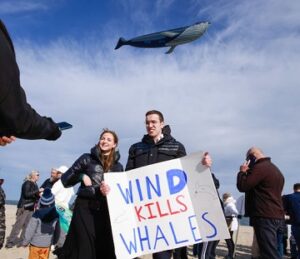 New Jersey is in the process of approving two major offshore wind projects: the Ocean Wind I and II initiatives owned by the Danish “green” energy company Ørsted. Radical leftist Governor Phil Murphy ordered a massive restructuring of the state’s power grid in September to become reliant on “100 percent clean energy by 2035” that has enjoyed enthusiastic support from the White House, which approved Ocean Wind I in July. To install the wind turbines necessary for the projects, engineers must survey and map the ground floor to find the ground best able to sustain the massive structures. The survey work being done in anticipation of the installation of these turbines has coincided with a massive increase in the number of dead whales and other marine mammals off the coasts of New York and New Jersey. >click to read< 10:28
New Jersey is in the process of approving two major offshore wind projects: the Ocean Wind I and II initiatives owned by the Danish “green” energy company Ørsted. Radical leftist Governor Phil Murphy ordered a massive restructuring of the state’s power grid in September to become reliant on “100 percent clean energy by 2035” that has enjoyed enthusiastic support from the White House, which approved Ocean Wind I in July. To install the wind turbines necessary for the projects, engineers must survey and map the ground floor to find the ground best able to sustain the massive structures. The survey work being done in anticipation of the installation of these turbines has coincided with a massive increase in the number of dead whales and other marine mammals off the coasts of New York and New Jersey. >click to read< 10:28
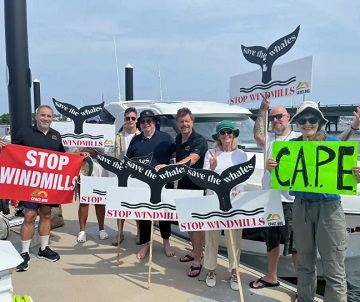
Fishermen, activists protest offshore wind farms near Montauk, cite recent whale deaths
The winds of change are blowing. Conservative activists, environmentalists and New Jersey fishermen protested the construction of wind turbines off the East Coast on Monday, highlighting increasing whale deaths in the region that they say are tied to offshore renewable energy. The coalition, organized by the Committee for a Constructive Tomorrow, sent out three boats to South Fork Wind Farm, roughly 20 miles from both Martha’s Vineyard and Montauk, NY, holding signs that read “STOP WINDMILLS SAVE WHALES” while shouting through a bullhorn at machinery operators to halt construction. The National Oceanic and Atmospheric Administration (NOAA) in 2017 declared an “unusual mortality event” for humpback whales found dead on beaches from Maine to Florida. The agency has recorded 57 large whale strandings since December 1, 2022 on the Atlantic coast. Twelve occurred in New York; nine were discovered in New Jersey. Photos, >click to read< 09:04

Long Beach council tells Hochul it is ‘fervently opposed’ to wind project
The City of Long Beach is “fervently opposed” to the Empire Wind 2 project that proposes a high-voltage power line through its streets and turbines visible from shore, city officials said in a letter to Gov. Kathy Hochul this week. The Monday letter, signed by all five city council members, including president John Bendo, outlined four primary reasons the city stands in “firm opposition” to the project, which Norway-based Equinor proposes to have in service before the end of the decade. Equinor, in a statement, said it was “disappointed” by the letter,,, A spokesman for Hochul’s office didn’t respond to a request for comment. John McNally, a spokesman for the city, said the council was “resolute” in its opposition to the project, and that the letter “speaks for itself.” >click to read< 09:29
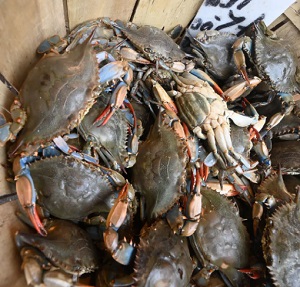
East Hampton fishing for stiffer laws against ‘organized crab crime ring’ stealing bushels of shellfish
Town officials are fishing for even stiffer laws in the war against “organized crab crime rings.” The tougher penalties are needed to turn the tide against “vans full of” out-of-towners bagging “bushels and bushels of shellfish out of Napeague Harbor” and other waterways including Georgica Pond, the town’s attorneys said. “They basically just start taking everything they can grab from the shallows and those two waters: from clams to scallops to conchs, hermit crabs, blue claw crabs. Pretty much grab any size of anything they can in sight,” said Chris Carillo, attorney for the town’s trustees. The night raiders employ a lookout to alert them to Marine Patrol officers and those who are caught don’t carry ID, and because it’s merely a violation, the offenders avoid being fitted for handcuffs, Carillo said. >click to read< 18:41

Peconic Bay Scallops are a legacy at risk
For more than 30 years, Tim Sweat has spent the early morning hours of winter on Peconic Bay. By noon on most days, he would collect thousands of pounds of scallops — enough to cover the daily cost of maintaining his boat, plus put aside some extra money for the holidays. But for the last four years, as bay scallops continue to die off at an alarming rate, he’s finished the season with little to show for his efforts. “I’ve spent most of my life out here on the water; fishing is my whole life. But the future is not looking very promising for the smaller boats like me,” Sweat said. “We’re struggling to make a living out here, things keep dying off.” >click to read< 13:33
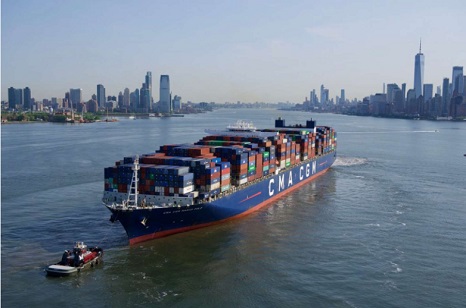
Why are the whales dying? Sea mammal deaths hit record in New York and New Jersey
As whales wash up along East Coast shores at alarming rates, researchers dissect decomposing carcasses, logging whether ship strikes or fishing gear factored into each demise, while some beachgoers wonder if their favorite coastline will be next. At least 14 humpbacks and minke whales have been found dead thus far in 2023 in waters off New York and New Jersey — up from 9 in the entirety of last year. The most recent deaths were two humpbacks, whose corpses were spotted May 31, in Raritan Bay off Keansburg, New Jersey, and Wainscott on Long Island. >click to read< 11:52
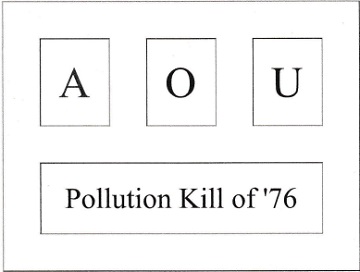
Pollution Kill of ’76
In 1976 Gosta “Swede” Lovgren of Point Pleasant N.J. witnessed first hand the destructive effects of a massive Fishkill, caused by an oxygen deprived dead zone that stretched from Long Island south to Atlantic city, and extended 40 to 50 miles to the east. In this article he describes firsthand not only the environmental aspects of the Fishkill, but his efforts to halt ocean sludge dumping. Swede was the leader of the commercial fishermen’s fight against ocean dumping which included filing a $500,000,000 lawsuit against the city of New York. Fascinating reading, well worth your time. >click to read< 09:09

North Carolina Joins Effort to Establish Regional Fisheries Mitigation for Offshore Wind Development
Governor Roy Cooper announced that North Carolina has joined other Atlantic Coast states involved with the Special Initiative on Offshore Wind on a coordinated project to support fisheries mitigation in the development of offshore wind along the East Coast. “It is important that we work to meet our state’s offshore wind energy goals while still protecting our marine fishery industry,” said Governor Cooper. “We are committed to collaborating with other states in this effort to make sure we achieve both goals.” Currently, the Initiative is focused on establishing a framework to compensate commercial and for-hire fishermen in the event of economic impact related to offshore wind development. The goal is to develop a regional approach for administration of any financial compensation paid by developers. Economic impacts from coastal fishing in North Carolina top $4.5 billion annually. >click to read< 08:26






